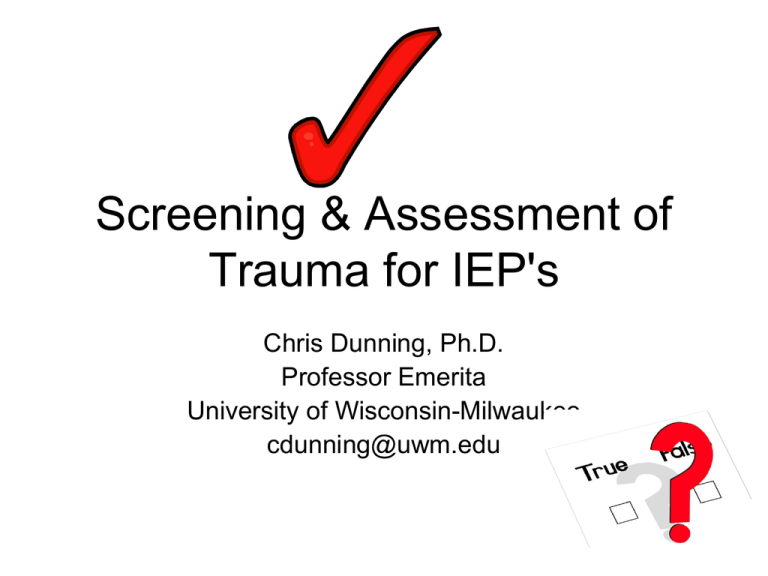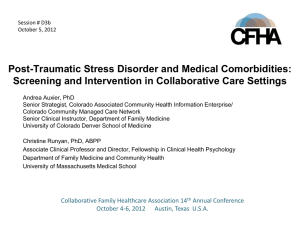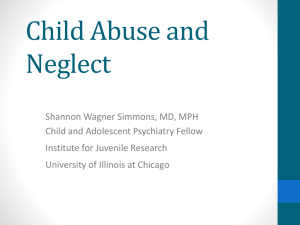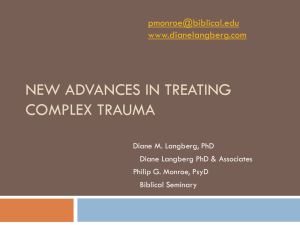Screening & Assessment of Trauma for IEP`s
advertisement

Screening & Assessment of Trauma for IEP's Chris Dunning, Ph.D. Professor Emerita University of Wisconsin-Milwaukee cdunning@uwm.edu Workshop Objectives • Increase ability to identify effects of child traumatic experience presenting at school • Connect trauma-based barriers to learning to student performance • Improve ability to use screening and assessment tools to inform consultation with teaching staff • Develop strategies to include trauma assessment in the development of IEPs. Why are we doing this? Trauma & Academics • Impact of trauma on school readiness • Impact of trauma on school performance • Impact of trauma on cognitive functioning that may result in behavioral difficulties • Increased likelihood of dropping out of school What affects learning associated with traumatic experience? Behaviors Health School Attendance Memory Cognitions Academic tasks that are difficult when experiencing trauma related conditions Concentrating Sitting Still Talking (When experiencing stress reaction) Controlling Impulses and Behavior Organizing Setting Priorities Making Decisions Processing Oral Information (When experiencing stress reaction) Contextualizing (associating concepts appropriately) Memory Remembering Reference • Nickerson, Amanda, Stephen Brock, et al (eds.) (2008) Identifying, Assessing, and Treating PTSD at School • Springer Pub. What needs to be Assessed? Not PTSD! Acute and Chronic Traumatic Stress • Traumatic Experience – Objective & subjective features • Appraisal/Response to Threat – – – – Scope of danger Reaction & regulation Protective responses Positive/negative adjustment • Proximal & Distal Reminders – Internal & external cues • Proximal & Distal Secondary Stress – Family functioning, social support, service system demands • Acute Reactions – Symptoms, developmental failure, learning impairments • Intrinsic Factors – Genetics, anxiety sensitivity, developmental status, trauma history • Social Ecology – Parent/Family functioning & psychopathology, school, peers • Proximal & Distal Development & Psychopathology – Biological maturation, cognitive & emotional development, impulse control, personality features • Repeated Exposure & Adversity – Subsequent trauma, chronic life adversity • Psychopathology – Premorbid & comorbid disorders, emergent vulnerability, treatment response What We’re Looking For LONG-TERM STRESS REACTIONS HEALTHY (Common) • LEVEL 1: Initial Crisis Reactions • LEVEL 2: Acute Stress Disorder • LEVEL 3: Post-Traumatic Stress Reactions • LEVEL 4: Post-Traumatic Stress Disorder UNHEALTHY (Uncommon) Stephen Brock 2008 Utilize comprehensive assessment. • Trauma-specific standardized assessments can identify potential risk behaviors (i.e. danger to self, danger to others) and help determine interventions that will reduce risk. • Thorough assessment can identify a student’s reactions and how his or her behaviors are connected to the traumatic experience. • Assessment results provide valuable information for developing treatment goals with measurable objectives designed to reduce the negative effects of trauma. • Assessment results also can be used to determine the need for referral to trauma-specific mental health care or more detailed trauma assessment. Issues which might require referral Acute Stress Disorder Post Traumatic Stress Disorder Dissociative Disorders Attachment Disorders Adjustment Disorders Where do you start? • Review existing school records for traumarelated markers – Enrollment pattern – Attendance – Health – Behavior/discipline – Outside agency connections – School performance Let’s Start with Health First Impact of Trauma over the Life Span Effects of ACEs* neurological biological psychological Social *Adverse Childhood Experiences Health Issues Related To Adverse Experiences In Childhood Smoking COPD Heart disease Fractures due to reenactment Diabetes Severe obesity/bulimia Compulsive overeating Alcoholism Other substance abuse IV drug use Early intercourse Teen pregnancy – including paternity Promiscuity Dysphagiadifficulty swallowing Pseudo-epilepsy An ACE—adverse childhood experience—is exposure to any of the following before the age of 18: 1. 2. 3. 4. 5. 6. 7. 8. Recurrent physical abuse Recurrent emotional abuse Sexual abuse An alcohol or other drug abuser in the household An incarcerated family member A household member who was chronically depressed, mentally ill, institutionalized or suicidal Violence between adults in the home Parental separation or divorce 16 Figure ES2. Prevalence of Individual ACEs in Wisconsin • Emotional Abuse • Substance Abuse In Household • Separation/divorce • Physical Abuse • Violence Between Adults • Mental Illness In Household • Sexual Abuse • Incarcerated Household Member 29% 27% 21% 17% 16% 16% 11% 6% 18 19 ACE Study Key finding 1: Expanding definition of childhood stress, trauma and “maltreatment” had real life significance beyond the event. Key Finding 2: Adverse childhood experiences can have an astonishingly broad based, harmful influence on adult health. (And the beginnings of a health impact are evident while in childhood.) Key finding 3: The health effects of adverse childhood experiences may not appear for decades. ACE Study Key Finding 4: The more kinds of adverse childhood experiences a participant reported the greater the risk for a given health problem (traumadose relationship). Key Finding 5: The more kinds of adverse childhood experiences a participant reported the greater the risk for more health problems (comorbidity). Adverse Childhood Experiences in Wisconsin: Findings from the 2010 Behavioral Risk Factor Survey. http://wctf.state.wi.us/index.php?section=adv erse-childhood or http://wichildrenstrustfund.org/index.php?sec tion=adverse-childhood The Child’s Brain Differences due to Trauma Hippocampal Volume Reduction in Childhood Abuse-related PTSD 1200 3 Hippocampal Volume (mm ) 1100 * 1000 900 PSD (N=17) Controls (=17) 800 700 600 *p<.05 500 Left Hippocampus Right Hippocampus 12% reduction in left hippocampal volume in abuse-related PTSD Brain Circuits in Trauma Spectrum Disorders: Brain Volumes Hippocampus Amygdala PTSD NC Depression/ Abuse NC mPreFront Cortex/ AC/ Obf BPD DID ? Hippocampal Volume Reduction in PTSD NORMAL PTSD Bremner et al., Am. J. Psychiatry 1995; 152:973-981. Bremner et al., Biol. Psychiatry 1997; 41:23-32. Gurvits et al., Biol Psychiatry 1996;40:192-199. Stein et al., Psychol Med 1997;27:951-959. DeBellis 1999-no change in children with PTSD J Douglas Bremner, MD, Emory University Child’s Brain Healthy Neglected/Abused Lateral Ventricles Measures in an 11 Year Old Maltreated Male with Chronic PTSD, Compared with a Healthy, Non-Maltreated Matched Control (De Bellis et al., 1999) Depression from Child Trauma 5-HTTLPR polymorphism Healthy Child Depressed Child Examples of Exclusions/Overlap So what is it? DSI, NVLD, ADHD, PTSD? Sensory integration Dysfunction Nonverbal Learning Disorder • • • • • DSI is a neurologically based disorder, like ADHD and learning disabilities. A child with DSI has an inability to organize sensory input for use in daily living, which includes school, play, and family life. The child has either a hyposensitivity or a hypersensitivity to sensory input, such as an overreaction to the feel of clothing or to the texture of food. DSI is similar to ADHD in that it impacts learning, but is not a learning disability. DSI overlaps with ADHD in symptoms of inattention and restlessness • (NVLD) is a type of learning disability where the child has deficiencies in nonverbal reasoning. NVLD overlaps with both ADHD and DSI: the child with NVLD can have the sensory sensitivity of a child with DSI and the impulsiveness, disorganization, and hyperactivity of a child with ADHD or with DSI. Auditory Distortions Auditory Perceptual Problem: Trouble taking information in through the sense of hearing and/or processing that information. Auditory discrimination problem - hearing an angry rather than a joking tone of voice. Auditory figure-ground problem - Trouble hearing a sound over background noise: for example, being unable to hear the telephone ring when one is listening to the radio. Stimuli Distortions Catastrophic response - An involuntary reaction to too may sights, sounds, extreme emotions or other strong stimuli.This may result in losing one's temper, becoming dazed or unaware of one's surroundings, or "freezing" for a short time. Cognitive Disorganization: Difficulty thinking in an orderly, logical way, People with this problem often jump to conclusions and have difficulty planning tasks. Body Distortions Crossing the Midline : Trouble with moving one's limbs across the center of the body. This could include: Difficulty writing across a page, sweeping a floor or controlling a steering wheel. Unaware of body parts, such as not being aware of self below waist. Sense Of Touch Tactile Perceptual Problem: Trouble taking information in through the sense of touch. Some tactile handicaps are: Immature Tactile System- People with this problem dislike being touched lightly, but crave pressure touch, such as being hugged hard or huddling with knees to their chest. Until the immaturity is overcome, tactical discrimination cannot develop. Tactile Defensiveness- Tendency to avoid being touched because of an immature tactile system. Sensory integration dysfunction (DSI or SI) • …can look like a learning disability, but it isn’t. • DSI is a neurologically based disorder, like ADHD and learning disabilities. • A child with DSI has an inability to organize sensory input for use in daily living, which includes school, play, and family life. • The child has either a hyposensitivity or a hypersensitivity to sensory input, such as an overreaction to the feel of clothing or to the texture of food. • DSI is similar to ADHD in that it impacts learning, but is not a learning disability. DSI overlaps with ADHD in symptoms of inattention and restlessness. Memory Problems Memory Problem - Short term,, Trouble remembering; names, numbers, specific facts, what happened a few minutes ago. A poor memory makes academic success difficult. Perceptual Problems: Trouble taking information in through one's senses and/or processing that information. Neurological Signs Soft Neurological Signs: Signs of central nervous system dysfunction that can be observed; staring, turning the head instead of moving the eyes, inability to look people in the eye, not holding the head straight, being easily startled. Impact of Recurrent ACE on Development • Chronic exposure to trauma may result in – deficits in the ability to identify internal emotional experience – difficulties with safe expression of emotions – impaired capacity to modulate emotional experience – regression in behavior and physical control needs Behavioral Presentations • Where do you start? – With school performance? – With Behavior? Emotional and behavioral consequences occurring across age groups: 1. Regression to childish/dependent behavior 2. Fears/anxieties 3. Changes in eating patterns 4. Changes in sleeping patterns 5. Gender differences 6. School problems 7. Disciplinary Referrals 8. Freezing 9. Dissociation Conditions Co-morbid with Child PTSD • • • • • • • • AD/HD Depression Obsessive/Compulsive Disorder Oppositional/Defiant Disorder Anxiety Disorder Conduct Disorder Intermittent Explosive Disorder Impulse Control Disorders Consequences of PTSD/Developmental Trauma Disorder Academic 1. Cognitive 2. Academic achievement 3. Academic performance 4. Grade retention 5. Adult outcome 6. School behavior Impact on Learning • • • • • • • Organizing narrative material Cause & effect Taking another's perspective Attentiveness Regulating emotions Executive functioning Engaging in curriculum Impact on Learning (continued) • Single exposure may cause – Jumpiness, intrusive thoughts, interrupted sleep and nightmares – Anger and moodiness, and/or, social withdraw any of which can interfere with concentration and memory Impact on Learning (continued) • Chronic exposure, especially during child’s early years (complex/developmental trauma) can adversely affect: – Attention, Memory, and Cognition – Reduce a child’s ability to focus, organize and process information – Interfere with effective problem solving and/or planning – Result in overwhelming of feelings of frustration and anxiety Impact on Classroom Behavior • • • • • Reactivity & impulsivity Aggression Defiance Withdrawal Perfectionism Academic Childhood trauma creates difficulty with: •Focus •Social functioning •Decline in academic performance •Outbursts of anger, hyperactivity, impulsivity All are symptoms often associated with LD Consequences of PTSD effects on cognitive functioning 1. Motivation and persistence in academic tasks 2. Development of short-and long-term goals 3. Sequential memory 4. Ordinal positioning 5. Procedural memory 6. Attention/Working memory Consequences of PTSD executive functioning All cognitions have an emotional context. •Educators must emotionally engage students •Learning does not occur without positive emotional engagement. •When in an acute emotional state, frontal lobes are “off-line.” •You have input and output. •Between input and output, organization needs to take place. •Have to have organization of input to get output. •Executive functioning is the conductor Differences Between Traumatized Student And Those Who Were Resilient Or With LD Sense of fatalism, Corrupt or evil self-esteem, Inconsistent cognitive abilities, Self-destructiveness, Impaired hope and fantasy, Hyperaroused behavior patterns Inability to use external support. Difficulties in Assessment of TraumaRelatedness • Internal experiences are difficult to articulate • Difficulty often in trusting adult during assessment since often a “trusted adult” perpetrated abuse • Resist disclosure—fearing further fragmentation of self or family • Concern about disclosure of unusual symptoms since they may be viewed as “crazy” • Symptoms may be confused with schizophrenialike symptoms (eg. Hearing voices) • Symptom pattern may change over time and age/development • Other symptoms may draw more attention Approaches to Assessment of Trauma 3 Basic approaches to assessment of trauma and post-traumatic sequelae through tools and instruments: – Instruments that directly measure traumatic experiences or reactions – Broadly based diagnostic instruments that include traumatic symptoms (PTSD subscales-not looking to diagnose PTSD) – Instruments that assess symptoms not trauma specific but commonly associated symptoms of trauma What students say when they present I can’t sleep • I have nightmares • I don’t want to be around people- Social withdrawal • I have …family problems …legal issues with the court …school problems ...aggression/anger …health symptoms …substance abuse …depression • Exposure Instruments-Child • Life Incidence of Traumatic Event (Child/Parent) • Dimensions of Stressful Events Rating Scale (DOSE) • Traumatic Events Screening Inventory (TESI) • My Worst Experiences Survey • When Bad Things Happen Scale Example: TESI Items • Has your child ever experienced the severe illness or injury of someone close to him/her? Yes No Unsure – IF YES, What was this person’s relationship to your child? – How old was your child? The first time:________ The last time:________ The most stressful:________ – Was your child strongly affected by one or more of these experiences? yes no unsure • Has someone ever physically assaulted your child, like hitting, pushing, choking, shaking, biting, or burning? Or punished your child and caused physical injury or bruises. Or attacked your child with a gun, knife, or other weapon? (This could be done by someone in the family or by someone not in your child’s family). Yes No Unsure – IF YES, What was this person’s relationship to your child? – Was a weapon used? unsure no yes Type? – How old was your child? The first time? The last time? The most stressful? – Was your child strongly affected by one or more of these experiences? yes no unsure NCTSN Child Welfare Toolkit: Trauma/Loss Exposure History But can you ask these questions?? Trauma Type Yes/Suspected/No/Unknown Age(s) Experienced (Check each box as appropriate – example sexual abuse from ages 6–9 would check 6, 7, 8, and 9) 1. Sexual Abuse or Assault/Rape 2. Physical Abuse or Assault 3. Emotional Abuse/Psychological Maltreatment 4. Neglect 5. Serious Accident or Illness/Medical Procedure 6. Witness to Domestic Violence 7. Victim/Witness to Community Violence 8. Victim/Witness to School Violence 9. Natural or Manmade Disasters 10. Forced Displacement 11 . War/Terrorism/Political Violence 12. Victim/Witness to Extreme Personal/Interpersonal Violence 13 . Traumatic Grief/Separation (does not include placement in foster care) 14 . Systems-Induced Trauma Repository of Information on Trauma Assessment Tools • http://www.ptsd.va.gov/professional/pa ges/assessments/list-trauma-exposuremeasures.asp • http://www.nctsn.org/sites/default/files/ assets/pdfs/cwt3_sho_referral.pdf Assessing Trauma’s Impact • Rather than documenting that the child has experienced a traumatic event – Child Stress Disorder Checklist-Saxe – Acute Stress Checklist for Children (ASCKIDS) Kassam-Adams Acute Stress Checklist for Children (ASCKIDS) Child self report Ages 817 • Assesses – Objective (A1) & subjective (A2) experience of trauma – Dissociation – Re-experiencing – Avoidance – Arousal – Impairment & Duration – Additional items related to fear of death, parental response & coping ASC-KIDS Items • I can’t remember some important parts of what happened • I felt in a daze-like I didn’t know what was going on • Pictures or sounds from what happened keep popping into my mind • I can’t stop thinking about it • I try not to think about what happened • I want to stay away from things that remind me of what happened • Since this happened, I get angry or bothered more easily • A sudden noise really makes me jump Traumatic Coping Kidcope Items 1. Distraction 2. Social withdrawal 3. Cognitive restructuring 4. Self-criticism 5. Blaming others 6. Problem solving 7. Emotional regulation 8. Wishful thinking 9. Social support 10. Resignation Kidcope Distraction • I Tried to Forget • I Watched TV/Played a Game Social Withdrawal • I Stayed by Myself • I Kept Quiet About the Problem Cognitive Restructuring • I Tried to See the Good Side of Things Self Criticism • I Blamed Myself for Causing the Problem Blaming Others • I Blamed Someone Else/Causing/Problem Problem Solving • I Tried/Fix the Problem/Thinking of Answers • I Tried/Fix the Problem/Doing Something or Talking with Someone Emotional Regulation • I Yelled, Screamed, got Mad • I Tried to Calm Myself Down Wishful Thinking • I Wished the Problem had Never Happened • I Wished I Could Make Things Different Social Support • I Tried to Feel Better Spending Time with Others like Family, Grownups, or Friends Resignation • I Didn’t do Anything Because the Problem Couldn’t be Fixed Child PTSD and General Symptom Screening Measures • Child Posttraumatic Stress Reaction Index (CPTS-RI) • The Child PTSD Symptom Scale (CPSS) • Children’s Impact of Traumatic Events ScaleRevised (CITES-2) • Parent Report of Child’s Reaction to Stress • Trauma Symptom Checklist for Children (TSCC) • Trauma Symptom Checklist for Young Children (TSCYC) CBCL Clinical Scales Scales • Total problems • Internalizing symptoms • Externalizing symptoms Syndrome subscales • Anxious-depressed • Withdrawn-depressed • Somatic complaints • Social problems • Thought problems • Attention problems • Aggressive behavior • Rule breaking behavior UCLA PTSD Index for DSM-IV–(Revision 2) (Rodriguez, Steinberg, & Pynoos, 2002) • 34-item parent-report (and 33-item youthreport instrument that screens school-age children and adolescents for all DSM-IV PTSD symptoms) • Allows for computation of severity scores for Criterion A1 and A2, Criterion B, C, and D. • Measure is split into the Youth Trauma Screen (trauma exposure and distress) and the PTSD Index (trauma symptoms). . • Construct validity: Part I items predict severity of peritraumatic dissociation and PTSD symptoms. UCLA PTSD Index Items • When something reminds my child of what happened he/she gets very upset, scared or sad (B) • My child has dreams about what happened or other bad dreams (B) • My child feels alone inside and not close to other people (C) • My child tries not to talk about, think about or have feelings about what happened (C) • My child feels jumpy or startles easily, for example, when he/she hears a loud noise or when something surprises him/her (D) • My child has trouble concentrating of paying attention (D) • My child feels that some part of what happened is his/her fault (AF) • My child is afraid that the bad things will happen again (AF) Tier 2 Trauma assessment screening DERS CPTSRI CANS CROPS/PROPS Sensory Regulation Experiential Therapies Group Trauma Interventions TARGET SPARCS SSET TGF-CBT Tier 3 Evidence-Based Trauma Interventions for Schools www.nctsn.org Individual Trauma Interventions TF-CBT CBITS (Child Behavioral Intervention for Trauma in Schools Sensory ExperiencingSE ADBT-SP (Adapted Dialectical Behavioral Therapy) Life Skills/Life Story SITCAP http://www.nctsn.org/resources/topics/treatments-that-work/promising-practices Trauma Knowledge is a work in Process This is not the End really-work continues on Developmental Trauma Disorder CONSENSUS PROPOSED CRITERIA FOR DEVELOPMENTAL TRAUMA DISORDER A. Exposure. The child or adolescent has experienced or witnessed multiple or prolonged adverse events over a period of at least one year beginning in childhood or early adolescence, including: A. 1. Direct experience or witnessing of repeated and severe episodes of interpersonal violence; and A. 2. Significant disruptions of protective caregiving as the result of repeated changes in primary caregiver; repeated separation from the primary caregiver; or exposure to severe and persistent emotional abuse B. Affective and Physiological Dysregulation. The child exhibits impaired normative developmental competencies related to arousal regulation, including at least two of the following: B. 1. Inability to modulate, tolerate, or recover from extreme affect states (e.g., fear, anger, shame), including prolonged and extreme tantrums, or immobilization B. 2. Disturbances in regulation in bodily functions (e.g. persistent disturbances in sleeping, eating, and elimination; over-reactivity or under-reactivity to touch and sounds; disorganization during routine transitions) B. 3. Diminished awareness/dissociation of sensations, emotions and bodily states B. 4. Impaired capacity to describe emotions or bodily states C. Attentional and Behavioral Dysregulation: The child exhibits impaired normative developmental competencies related to sustained attention, learning, or coping with stress, including at least three of the following: C. 1. Preoccupation with threat, or impaired capacity to perceive threat, including misreading of safety and danger cues C. 2. Impaired capacity for self-protection, including extreme risk-taking or thrill-seeking C. 3. Maladaptive attempts at self-soothing (e.g., rocking and other rhythmical movements, compulsive masturbation) C. 4. Habitual (intentional or automatic) or reactive self-harm C. 5. Inability to initiate or sustain goal-directed behavior D. Self and Relational Dysregulation. The child exhibits impaired normative developmental competencies in their sense of personal identity and involvement in relationships, including at least three of the following: D. 1. Intense preoccupation with safety of the caregiver or other loved ones (including precocious caregiving) or difficulty tolerating reunion with them after separation D. 2. Persistent negative sense of self, including self-loathing, helplessness, worthlessness, ineffectiveness, or defectiveness D. 3. Extreme and persistent distrust, defiance or lack of reciprocal behavior in close relationships with adults or peers D. 4. Reactive physical or verbal aggression toward peers, caregivers, or other adults D. 5. Inappropriate (excessive or promiscuous) attempts to get intimate contact (including but not limited to sexual or physical intimacy) or excessive reliance on peers or adults for safety and reassurance D. 6. Impaired capacity to regulate empathic arousal as evidenced by lack of empathy for, or intolerance of, expressions of distress of others, or excessive responsiveness to the distress of others E. Posttraumatic Spectrum Symptoms. The child exhibits at least one symptom in at least two of the three PTSD symptom clusters B, C, & D. F. Duration of disturbance (symptoms in DTD Criteria B, C, D, and E) at least 6 months. G. Functional Impairment. The disturbance causes clinically significant distress or impairment in at least two of the following areas of functioning: • Scholastic: under-performance, non-attendance, disciplinary problems, drop-out, failure to complete degree/credential(s), conflict with school personnel, learning disabilities or intellectual impairment that cannot be accounted for by neurological or other factors. • Familial: conflict, avoidance/passivity, running away, detachment and surrogate replacements, attempts to physically or emotionally hurt family members, nonfulfillment of responsibilities within the family. • Peer Group: isolation, deviant affiliations, persistent physical or emotional conflict, avoidance/passivity, involvement in violence or unsafe acts, ageinappropriate affiliations or style of interaction. • Legal: arrests/recidivism, detention, convictions, incarceration, violation of probation or other court orders, increasingly severe offenses, crimes against other persons, disregard or contempt for the law or for conventional moral standards. • Health: physical illness or problems that cannot be fully accounted for physical injury or degeneration, involving the digestive, neurological (including conversion symptoms and analgesia), sexual, immune, cardiopulmonary, proprioceptive, or sensory systems, or severe headaches (including migraine) or chronic pain or fatigue.








